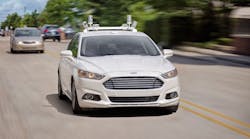Ford Motor Co. aims to have a fully autonomous vehicle available by 2021 for ride-hailing services, skipping the interim steps of driver-assisted technology and matching BMW’s ambitious timeframe.
The second-biggest U.S. automaker said earlier Tuesday that it’s doubling the number of people at its Silicon Valley technical center while expanding to two more buildings. Ford also invested $75 million in the leading maker of an advanced radar system to accelerate its development of self-driving cars.
Ford chose to focus on purely self-driving vehicles that don’t require a human to take over in complex situations, said Raj Nair, Ford’s head of product development. The automaker is chasing Alphabet Inc.’s Google self-driving car project as well as efforts by General Motors Co. and other automakers. Ford said today it’s investing in or collaborating with four startups on autonomous vehicles, bringing its roster of such partnerships to 40.
“We see the autonomous car changing the way the world moves once again,” Chief Executive Officer Mark Fields said at Ford’s Palo Alto, California, lab, which will expand its workforce to 260 and increase sixfold in size to 180,000-square feet over three buildings. “They address a whole host of safety, social and environmental issues.”
Ford’s plan lacks specifics of how it will make this great leap, said Michelle Krebs, senior analyst for researcher Autotrader.
“I’m not seeing all the pieces of the puzzle in place because they don’t have a relationship with a ride hailing service like Uber or Lyft," Krebs said. "It’s a first step and at least Wall Street will see that they’re working on this.”
Lidar Investment
Ford and China’s top search engine company, Baidu Inc., are each investing $75 million in Velodyne Lidar Inc., the automaker said in a statement. Lidar bounces light off objects to assess shape and location, giving self-driving cars a 360-degree view of their environment with the help of cameras and traditional radar. Morgan Hill, California-based Velodyne said the money will help it improve design and expand production, making the sensors more affordable for mass adoption.
“They want to do as much as they can internally, but also acknowledge that it’s best to partner with those who have the leading technology,” Jeff Schuster, an analyst at research firm LMC Automotive, said of Ford.
General Motors spent almost $1 billion acquiring self-driving software maker Cruise Automation and invested $500 million for a 9 percent stake in ride-hailing company Lyft Inc. Fiat Chrysler Automobiles NV has teamed with Google to develop 100 self-driving minivans. Ford conducted unsuccessful negotiations with Google prior to the Chrysler deal.
GM Acquisitions
Since GM announced its acquisition of Cruise Automation in March, the staff at the company has grown to 100 from 40, said Kevin Kelly, a GM spokesman. GM is testing Cruise’s self-driving software on Chevy Bolt electric cars in Scottsdale, Arizona. GM also has a research lab in Palo Alto that employs about 12 people, Kelly said.
“Our goal is to use our autonomous technology in an on-demand ride-sharing network,” Kelly said. “Cruise paired perfectly with Lyft.”
Velodyne said it “expects an exponential increase in lidar sensor deployments” and that it will continue to work with top automotive and ride-sharing companies worldwide.
“We want the cost to be low enough to be used for all cars,” Marta Hall, Velodyne’s president of business development, said in the statement.



